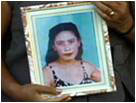
Discourse in Favor of the Victim
In the documentary Senorita Extraviada, by Loudes Portillo, we see an in-depth analysis of discourse in the form of photography. Portillo illustrates how photography can reinforce gender hierarchy and also function as a tool to memorialize the dead women of Juarez and encourage other women to fight for social change and justice. The visual discourse in Senorita Extraviada informs the viewer on the power of technological agency and the importance to critically engage the technological institution of photography.
Portillo attempts to counteract the media images of the victim with a more positive image of these women as real people with real lives. Portillo combats current understanding of the Juarez murder victim by different camera techniques and different types of textual and verbal rhetoric. Portillo refuses to make a spectacle of the gendered practices of sexual violence and instead takes an in-depth analysis and critic of the violence and injustices to which these women have been objectified to. (Nathan, 2003)
An important technique which Portillo uses is filming young women who are still alive. For example, family members tell first hand stories of the disappearances and also personally stories about the lives of the victims. Most importantly many times the families are talking about their loved ones with the victim's photo in a frame in their hands.

These victims are no longer sexualized maquiladora workers, but women who had families and friends and lived diverse and meaningful lives. This tactic combats the usual visual rhetoric that de-humanizes and stereotypes the victim. Each victim has a different story and a different family.
Also, there are many sequences in which alive women are visualized "looking at the world as subject instead of objects of the gaze". (Nathan, 2003) For example, in the cover of the documentary we see an image of a different type of Mexican women then what is typically visualized.

This woman seems more natural. She has less makeup one and a less sexualized styled hair. This acts to represent these women in a more natural way which is not controlled by male-visions of beauty. Also, the setting of the photo is very important. This woman, in contrast to the typical portraits released by the media, is in a natural setting. She is in the desert, her hair is flowing freely and she is actively engaged in visualizing her surroundings. This women is alive and observing the same deserts which have claimed the lives of so many of her fellow women. She is not frightened victim, but a strong and reverent example of a Juarez women. Most importantly this is not a photo of a victim. By using women who are not dead in images such as this; Portillo intended meaning is hope for the future and as a reminder of the dead who were once living and those who are alive and living in the current state of fear, uncertainty, and injustice.
Furthermore, Portillo uses film and photography as a means of creating a discourse which is intended to empower the dead andmemorialize them as they would want to be remembered; which are not as victims of sexualized violence who are prisoners to a male hierarchy, but as women who were searching and working for a better existence. The images used in this film are intended to also empower women in Juarez and also encourage these women to fight and demand justice and not forget those who have been denied justice. Finally, she does not focus on the deaths, but instead focuses on the reality that these women lived and this documentary is a testament to the daily struggles of the women of the Juarez. The documentary is a political piece of visual and textual discourse which fights for justice and social change for the women of Juarez.